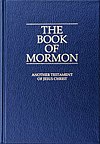|
Book of Enos
The Book of Enos (/ˈiːnəs/) is the fourth book in the Book of Mormon and is a portion of the small plates of Nephi.[1] According to the text it was written by Enos, a Nephite prophet. Most scholars believe it to be a 19th century work by Joseph Smith. Identity of Enos According to the Book of Mormon, Jacob had a son named "Enos" (see Jacob 7:27) and the Book of Enos follows immediately after the Book of Jacob in the manuscripts of the Book of Mormon and all printed editions. (See Jacob 7:27 to Enos 1:1.) However, in the opening verse of the Book of Enos (Enos 1:1), Enos mentions only his "father" and does not expressly affirm that his father was Jacob or that his uncle was Nephi. It is a reasonable assumption that Enos was the son of Jacob (of Jacob 7:27); but that relationship is not established in the text. Given the issues that have been debated about how it could have been fully 179 years between the time when Lehi (and Nephi) left Jerusalem and when Enos "began to be old" (Enos 1:25) and was "soon" to "go to the place of [his] rest" (Enos 1:27), it is possible either that Jacob and Enos each lived to about 95 years of age, with Jacob fathering Enos late in life, or that Jacob had one son named Enos (as stated in Jacob 7:27) and yet that the Enos of the Book of Enos was another Enos altogether, perhaps, for example, a grandson or even great-grandson of Jacob. The identity of Enos of the Book of Enos is not necessarily established as the son of Jacob and grandson of Lehi and Sariah. Clearly, however, Enos's ancestry leads directly to Lehi and Sariah through Jacob. Summary of the Book of Enos This short book consists of a single chapter, relating Enos' conversion after praying all day and all night, following with his subsequent dialogue with the Lord. It also discusses the redemption of the Nephites and their enemies, the Lamanites, and contains prophecies of future Nephite and Lamanite generations. Additionally, it contains descriptions of the Lamanites. The style of Enos resembles that of Erich Auerbach in his Mimesis and that of Nephi, Enos's ancestor and the Book of Mormon's opening narrator. NarrativeEnos hunts in the woods and remembers the gospel that his father taught him; as a result, he kneels and cries all day and during the night for the salvation of his soul.[2] Then the voice of God tells Enos that he is forgiven of his sins. Enos believes the voice, but he wonders how the forgiveness is actually accomplished.[3] In response, God explains that Enos is forgiven because he has faith in Jesus Christ, even though he has never seen or heard Christ.[4] Enos then prays for the salvation of the Nephites, but God says they will be blessed or punished according to their obedience.[5] Enos, fearing that the Nephites will refuse to obey the commandments of God, then prays for the Lamanites who oppress them; he asks God for the Lamanites' preservation. Additionally, he prays that God will preserve a record of the Nephites so that someday the Lamanites too might be brought to salvation. Only faith in Christ will save them, but God makes a covenant with Enos that he will bring the records of the Nephites to the Lamanites in due time.[6] After this experience, Enos takes up the mantle of prophet and preaches among the Nephites,[7] fearing their destruction. In the record, Enos does not say whether he is successful at converting the Nephites, but he does say the Nephites fail to convert the Lamanites.[2] Before Enos dies he gives the records to his son Jarom.[8] Portrayal of LamanitesThroughout the narrative, Enos characterizes the Lamanites as possessing an unmoving hatred. According to Enos, the Lamanites become a wild, idolatrous, and bloodthirsty people, eating predatory animals. They live in tents, wander around in the wilderness, wear loincloths, shave their heads, and often eat raw meat.[9] Enos explains that they are skilled with bows, cimeters, and axes and continually seek to destroy the Nephites. Fatimah Salleh and Margaret Olsen Hemming noticed that Enos implies that Lamanite practices, like eating raw meat, connote corruption, even though the same behavior had no negative connotations earlier in the Book of Mormon when the Nephites and Lamanites were still one people. Thus, Enos demonstrates "writer's bias." Hemming and Salleh concluded that Enos's criticism of the Lamanites is based more on prejudice and what is culturally acceptable to the Nephite rather than based on a charge from God.[10] Book of Enos interpretation
Enos begins his account in a manner that is similar to Nephi's: he mentions parental influence, passed on through religious counsel.[12] The narrative not only begins with this but also ends with it.[13] A difference from the style of Nephi is that Enos does not quote scripture in his narrative.[14] Terryl L. Givens also argues that Enos' intended literary audience leans toward the Lamanites, as the Nephites will eventually be destroyed.[15] According to author Dennis Largey, the style of the Book of Enos implies that Enos did not narrate it over a long period of time but may have narrated it shortly before he died.[16] On another note, literary critic Richard Rust compares the style and syntax of the Book of Enos and that of Erich Auerbach's Mimesis account of when Abraham is about to sacrifice Isaac. Specifically, Rust noticed in both accounts similar uses of modifiers as well as “and.”[17] Additionally, Enos fills his narrative with words such as "wrestling" that generally appeal to a reader's emotions, says Protestant theologian John Christopher Thomas.[18] The familial and covenantal responsibilities that Enos feels bring a serious but personal flavor into the narrative, according to BYU English professor Sharon J. Harris.[19] See alsoNotes
Works cited
Further reading
External links
|
